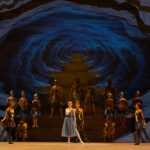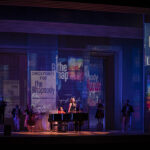Christopher Wheeldon’s Nutcracker, at the Joffrey Ballet Chicago, Revitalizes a Holiday Classic
The strains of Tchaikovsky’s lush, spritely overture soar as the Chicago Philharmonic begins The Nutcracker, but when the curtain rises, we find that we are not, as we may expect, in the expansive living room of a traditional Victorian home. Instead, it’s Christmas Eve 1892 in Chicago, and one family on the outskirts of town conducts its fairly frugal preparations for Christmas Day.

In this new Joffrey production by Tony Award-winning director/choreographer Christopher Wheeldon, young Marie lives in a working-class home with her brother and her mother, who is raising them alone. Mother is a sculptor by trade, currently involved in preparations for the 1893 World’s Columbian Exposition in the heart of Chicago, and she has invited her fellow workers to her modest home for Christmas Eve. As they begin their celebration, who should arrive but the Impresario — the architect of the exposition, modeled after real-life world’s fair architect Daniel Burnham with a smattering of scientist Nikola Tesla — who replaces the formidable Uncle Drosselmeyer as the pivotal character in Marie’s holiday story. He brings the important gift of a nutcracker that sets the wheels of fantasy in motion.
It’s a multi-layered story grounded in a topical reality, crafted with skill by Caldecott Award-winning children’s author Brian Selznick. Wheeldon told the Chicago Tribune that he had a specific vision for this new production, “… to find a way to tell the story that was a little bit more socially conscious and relatable to kids who don’t have the luxuries of a big family Christmas every year.”
Within this working-class environment, however, Marie has the capacity for extraordinary dreams. The child’s new Nutcracker becomes large as life, the family Christmas tree grows to enormous height, an army of rats challenges the toy soldiers, and Marie and her prince are transported to a fairyland of otherworldly adventures. Wheeldon’s staging places Act II’s specialty dances in Marie’s vision of the exposition to come, opening one pavilion after another to reveal dancers who came from around the globe to entertain her.

A Blue-Ribbon Design Team
To bring this Nutcracker to life, Wheeldon and Joffrey engaged some of the finest designers in the industry: Tony-nominated scenic and costume designer Julian Crouch, six-time Tony-winning lighting designer Natasha Katz, world-renowned puppeteer Basil Twist and Broadway projection designer Ben Pearcy.
Crouch had a significant advantage in approaching the production: He had no preconceived ideas about what a Nutcracker should be, because he’d never seen one. “The Nutcracker is not a big tradition in the United Kingdom,” he said. “We do pantomime, a very strange, archaic art form. So the first thing I had to do was watch a bunch of Nutcrackers.”
He admits that he was so naïve about the ballet that he assumed that at some point, the Nutcracker would actually crack some nuts. “So we have dancing nuts,” he said. The gracefully split walnuts are part of the children’s ensemble, a cadre of nearly one hundred young dancers who appear throughout the production.
He did have a working familiarity with the 1893 Columbian Exposition, however, because he’d designed another project in that setting. “The Chicago world’s fair is the influence, with its wide, great-moment-type architecture. We had to push the fantasy element — we looked at a version that was more historically accurate and decided it wasn’t fancy enough. This is the dream of a girl about what the fair might be — it has not opened yet. So we were able to take a lot of poetic license.”
Crouch also gleaned inspiration from the original Nutcracker, first performed by the Moscow Ballet in Russia a week before Christmas in 1892 — exactly the date on which the new Joffrey Nutcracker is set. “I looked at the original Nutcracker and used that concept in the Act II backdrop,” he said.
Chicago’s Auditorium Theatre, where the Joffrey performs, also lent influence to the scenic design. “It’s a very grand theatre, designed for the world’s fair,” Crouch said. “I reflected this in the set, using the same arches.”
Katz also had never seen a performance of The Nutcracker, even though she knew of a number of productions while she was growing up in New York City. “In the world of ballet, everyone has seen all sorts of different Nutcrackers, and there are ways you’re supposed to do things in this moment or that moment,” she said. “I didn’t have those thoughts, so I could respond to Chris, and to the music. He so changed each of those moments from what they normally are that we both started from a clean slate. It was very instinctual, and I found that extremely exciting.”
She enhanced the sense of realism and poverty in the first act with deliberately cool, steel blue lighting. “Nothing is warm at all in the stark part of the ballet,” she said. “In Act II, it’s really her fantasy, so it’s filled with color.” The effect is rather like MGM’s The Wizard of Oz, when Dorothy leaves her monochrome world and opens the door on a Technicolor® Munchkin Land for the first time.

A Tree Grows in Chicago
“In this story Marie’s a poor girl with hardly any money, and rats are running around her house,” said Katz. “They have a pathetic little Christmas tree.”
The rats, puppets created by Twist, scamper along the top of a fence and are lifelike enough to send shivers down audience members’ spines.
“The tree is placed upstage of a sheet while the Impresario puts on a magic show,” said Katz. “There’s one light on the tree — that’s actually supplied by Basil. Meanwhile, I take all of the light off the sheet, but at the same time I’m lighting the characters. When the light goes off, the projections come in.”
Then suddenly, the tree begins to grow. It’s an ingenious combination of projections, lighting and puppetry that turns the weak little sapling into a gloriously spreading evergreen
As audience eyes automatically follow the bright lights on the characters, the magic happens in the dark. Twist’s puppeteers replace the meager tree with a grander one, and projections create a further distraction while expanding the tree at the same time. “We project on puppeteers who are moving bits of the tree around,” said Pearcy. “It’s the combination of Basil’s puppetry with Natasha’s lighting with Julian’s set — through the whole sequence, each department has its specific role at specific times. Working all of that out was a challenge. Some of our original ideas didn’t work; some of the ideas we had later were better than what we had going in.”
Reality Inspires Fantasy
Crouch also designed the costumes for the ballet, including the heads for the Nutcracker and the mice. “I started off as a mask maker, so I knew that they had to be very, very light, and there had to be as much visibility as possible,” he said.
To achieve this, he found a commercially available product to act as the armature: “A framework of very cheap IKEA baskets,” he explained. “They are very light, thin bamboo. Two together and one for the hat — they created just the right shape. IKEA actually stopped selling them while we were making the heads, so I had just enough.” The baskets are covered with cheesecloth and batting and then painted, adding as little weight as possible so the dancers can move freely while wearing them.

Pearcy applied projection work to make the battle scene larger than life, and lighting carried the excitement forward. This proved to be a challenging scene for Katz. “We relit the battle a couple of times until we got the tone correct,” she said. “It’s the beginning of Marie’s fantasy, so we wanted to show it and expose it. But then it became too exposed and lost any kind of excitement. That’s when color comes in.”
She found that carving away some of the light actually made the scene more accessible to the audience. “The lighting is very specific about where your eye is supposed to go,” she said. “You know when you’re supposed to look at the rat king, because everyone else falls into the shadows. The pinpoint of light, the focus of the light, is like editing in the movies. You look where the light directs you to look.”
When it’s time for Marie and her prince to move from the Christmas tree out into the frozen world of snow, Pearcy designed projections that create a freezing effect over the entire stage, with the world’s fair in the background. Snow begins to fall as the fantasy sequences begin.
Marie and her Nutcracker prince drift across the stage in a graceful boat, one based on a statue that stood as the centerpiece of the 1893 exposition. They arrive at this fantasy fairground to meet the Spirit of the Fair — a role previously known as the Sugar Plum Fairy. “There’s a statue that still exists in Chicago — the Statue of the Republic — that was put in for the opening of the fair, and she is that,” said Crouch.
“For the second act, Chris had the idea that all of the short pieces would take place in pavilions from the world’s fair,” said Pearcy. “So we invented what we thought the pavilions might look like in the context of the set. We took inspiration from old posters, some images and textures that felt like those places might have been around that time.”
Business Unusual
With two years of creative collaboration behind them, the artistic staff joined together to tech the ballet in the Hancher Auditorium in Iowa City before moving it to Chicago for its official opening.
Supervising five rotating companies of dancers and a massive production crew would be a monumental challenge for any director, but Wheeldon brought an additional hardship to the tech rehearsals: Early in the process, he stepped backward off the edge of the stage in the dark and fell into the orchestra pit, breaking his ankle.
“He went to the hospital and came back three hours later with a cast on his ankle,” said Katz. “There he was, teching with us, with this cast.” Wheeldon spent the rest of tech week in a wheelchair.
After five previews at the Hancher, the production moved back to Chicago. “We had only two days on the stage — a fairly significant change,” said Pearcy. “We had panels on the sides of the proscenium that we did not have in Iowa, so we had to execute very quickly. But we do work very quickly — we’ve all worked with Chris before, and I’ve worked quite a bit with Julian. We were able to make changes up until the last minute.”
This design team has learned to function as a cohesive unit, said Katz. “For example, Ben is creating a background with projections, and I’m lighting downstage, and I might say to Ben, ‘Could you make the background a little bluer?’ It used to be I’d be making the background bluer, but with projections it’s a new language. We’re all in each other’s heads and we’re trying to help each other out, and it’s a beautiful thing.”
The result is a magical new Nutcracker that seems destined to remain in the Joffrey repertoire for a long time to come.


